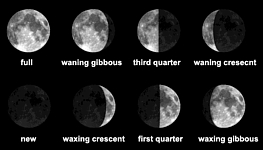6) The Moon takes about 28 days to complete a cycle of phases.
 Although it is not necessary to understand yet (imagining nothing in astronomy) why the lunar phases occur, an observer can do the simple exercise of contemplating how this object is seen illuminated in different proportions each day, illuminating more or less each time, until reach the same starting position and start again. By listing the days based on how many times the Sun has completed the rising and setting routine, the observer can determine how long it takes for the Moon to return to the same phase originally observed, which will result in about 28 days. To determine this, a little more than 1 month of monitoring is needed, although it is assumed that the observer does not know from the start the information on how long a complete lunation takes.
Although it is not necessary to understand yet (imagining nothing in astronomy) why the lunar phases occur, an observer can do the simple exercise of contemplating how this object is seen illuminated in different proportions each day, illuminating more or less each time, until reach the same starting position and start again. By listing the days based on how many times the Sun has completed the rising and setting routine, the observer can determine how long it takes for the Moon to return to the same phase originally observed, which will result in about 28 days. To determine this, a little more than 1 month of monitoring is needed, although it is assumed that the observer does not know from the start the information on how long a complete lunation takes.
Preliminary conclusion: Determination of the phases of the Moon. The Moon can be seen at night or day, depending on the date, and tracking its phases is quite simple. Determining the period of lunation is only a first step in solving the most important question: why do the phases occur? For which it is necessary to know a few more things as we progress through these experiences.
7) The Moon appears in a more "rearward" position in the sky every day.
 As one follows the Moon in the previous exercise, it is quickly possible to notice that the Moon appears to be more delayed each day. Although this does not affect the fact that it moves in the same direction as the Sun (from the point of "rise" to the point of "set"), its daily position seen at the same instants shows it to be more delayed. This is a first step towards understanding the lunar phases and the Moon's own motion, which, although it is constant across the sky, is evident that something is "delaying" its position relative to the background of stars. It is also interesting to note, both from this and the previous experiment, that the Moon always shows the same face to the Earth, and the explanation of this requires knowing the concepts of rotation and translation.
As one follows the Moon in the previous exercise, it is quickly possible to notice that the Moon appears to be more delayed each day. Although this does not affect the fact that it moves in the same direction as the Sun (from the point of "rise" to the point of "set"), its daily position seen at the same instants shows it to be more delayed. This is a first step towards understanding the lunar phases and the Moon's own motion, which, although it is constant across the sky, is evident that something is "delaying" its position relative to the background of stars. It is also interesting to note, both from this and the previous experiment, that the Moon always shows the same face to the Earth, and the explanation of this requires knowing the concepts of rotation and translation.
Preliminary conclusion: Knowing the proper motion of the MoonThe "delay" that the Moon experiences in its appearance on a daily basis is an unequivocal sign that there are different speeds involved, when this delay is observed at night: that of the apparent movement of the stars with respect to the Moon's own motion. This is a first indication that the Moon is much closer than that "star background", and that it also moves independently, so that we can conclude, in a very basic way, that the Moon is moving in relation to (or around) this star background, which in turn is constantly moving, but also does so at a slower speed than the latter.

